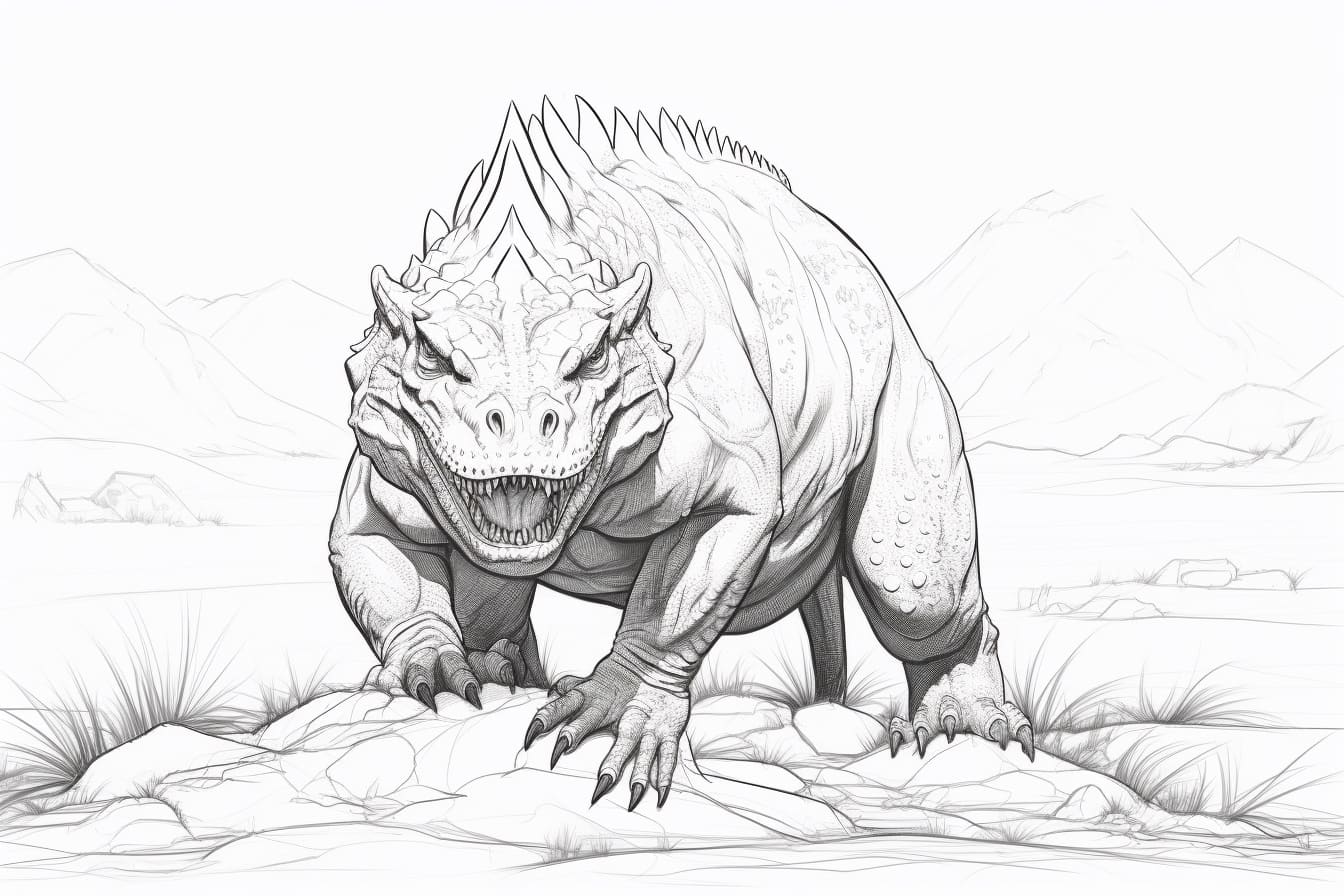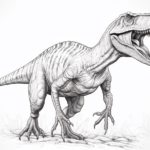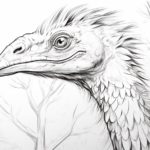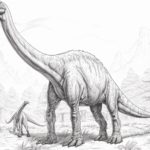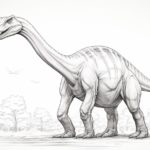Welcome to the fascinating world of drawing Carnotaurus, a fearsome predator that roamed the Earth during the Late Cretaceous period! This unique dinosaur, known for its distinctive horns and powerful build, provides a thrilling subject for artists looking to capture the essence of prehistoric life on paper. In this lesson, we will delve into the anatomy and characteristics of Carnotaurus, exploring how to translate its dynamic form onto the canvas with confidence and skill. Get ready to unleash your creativity and bring this ancient creature to life through the magic of drawing!
Materials Required
To draw a Carnotaurus, you will need the following materials:
- Drawing paper or sketchbook
- Pencils (preferably a range of graphite pencils for different shading effects)
- Eraser (both kneaded and regular erasers for precision erasing)
- Sharpener
- Ruler (for measuring proportions and straight lines if needed)
- Reference image of a Carnotaurus (to guide your drawing)
- Optional: Colored pencils or markers for adding color to your drawing
How to Draw a Carnotaurus: a Step-by-step Guide
Step 1: Gather Your Materials
Before starting to draw a Carnotaurus, make sure you have all the necessary materials at hand. These include a pencil, eraser, paper, and reference images of Carnotaurus for inspiration.
Step 2: Sketch the Basic Shapes
Start by lightly sketching the basic shapes that will serve as the framework for your Carnotaurus drawing. Begin with an oval for the head and a larger oval for the body. Add smaller ovals for the limbs and tail.
Step 3: Define the Head and Body
Refine the shape of the head by adding details such as the eye socket, nostrils, and the distinctive horns above the eyes that Carnotaurus is known for. Add the jawline and sketch the body to give it a more defined form.
Step 4: Add Limbs and Tail
Extend the smaller ovals you drew earlier to define the limbs of the Carnotaurus. Pay attention to the proportions and angles of the legs to ensure they look realistic. Add the tail, making it strong and muscular to support the dinosaur’s body.
Step 5: Refine the Details
Once you have the basic shapes and proportions in place, start adding more details to bring your Carnotaurus drawing to life. Add scales along the body, texture to the skin, and claws on the feet. Pay attention to the finer details to make your drawing more realistic.
Step 6: Shade and Add Depth
To give your Carnotaurus drawing depth and dimension, start shading different parts of the dinosaur. Use light shading for areas that are in shadow and darker shading for areas that are in direct light. Pay attention to the light source to create a more realistic effect.
Step 7: Final Touches
Once you are satisfied with the shading and details of your Carnotaurus drawing, go over the lines with a darker pencil or pen to make them stand out. Erase any remaining construction lines and refine any areas that need touching up. Add any final details or textures to complete your drawing.
Step 8: Sign and Date Your Artwork
Finally, sign and date your Carnotaurus drawing to mark it as your own. You can also add any additional touches or personal flair to make the drawing uniquely yours. Congratulations on completing your Carnotaurus drawing!
Conclusion
In conclusion, drawing a Carnotaurus can be a challenging yet rewarding experience for artists of all skill levels. By breaking down the steps, understanding the proportions and anatomy of the dinosaur, and practicing regularly, artists can capture the unique characteristics of this prehistoric creature in their artwork. Remember to have patience, enjoy the process, and let your creativity shine through as you bring the Carnotaurus to life on paper. With dedication and practice, anyone can master the art of drawing this fascinating dinosaur.
Fun Facts About Carnotauruses
- Carnotaurus was a large theropod dinosaur that lived during the Late Cretaceous period, around 72 to 69 million years ago.
- Its name, Carnotaurus, means “meat-eating bull,” and it was named for the horns on its head that resemble those of a bull.
- Carnotaurus had a unique feature among theropod dinosaurs – unusually short, deep skulls with large, forward-facing eyes. This gave it excellent binocular vision for hunting prey.
- The most distinctive feature of Carnotaurus is the two large horns above its eyes, which could have been used for display purposes or possibly in combat with other Carnotauruses.
- Despite its intimidating appearance, Carnotaurus had very small, vestigial arms with only two fingers each. These arms were likely not used for hunting or grasping prey, but may have played a role in mating rituals or balance.
- Carnotaurus was a relatively fast and agile dinosaur, with a streamlined body and powerful legs that allowed it to chase down prey.
- Fossil evidence suggests that Carnotaurus may have had a unique hunting strategy compared to other theropods. Its short, deep skull and strong neck muscles may have allowed it to deliver powerful, quick bites to its prey.
- Carnotaurus was discovered in Argentina, where many well-preserved dinosaur fossils have been found. Its fossils have provided valuable insight into the diversity and evolution of theropod dinosaurs in the Late Cretaceous period.
- Despite its fearsome appearance, Carnotaurus was likely not at the top of the food chain in its ecosystem. Larger predators like Giganotosaurus and Mapusaurus would have posed a significant threat to Carnotaurus.
- Carnotaurus is a popular dinosaur among paleontologists and dinosaur enthusiasts due to its unique features and fascinating evolutionary adaptations.
Suggestions for Scenes and Settings for Carnotaurus Drawings
Certainly! Here are some specific suggestions for scenes and settings to draw Carnotaurus in:
- Prehistoric Jungle: Illustrate Carnotaurus prowling through a lush, dense prehistoric jungle with towering ferns and ancient trees in the background.
- Dinosaur Battle: Show Carnotaurus engaged in a fierce battle with another dinosaur, such as a Triceratops or a Velociraptor, in a dramatic and action-packed scene.
- Volcanic Landscape: Depict Carnotaurus in a rugged, volcanic landscape with smoking volcanoes and molten lava flows in the background, creating a sense of danger and excitement.
- Dusk or Dawn: Capture Carnotaurus at dusk or dawn, with the soft golden light casting a warm glow on its scales and the surrounding landscape, creating a beautiful and atmospheric scene.
- Desert Oasis: Draw Carnotaurus near a desert oasis, with palm trees, a shimmering pool of water, and colorful desert flowers, creating a contrast between the fierce dinosaur and the serene oasis.
- Ice Age Tundra: Illustrate Carnotaurus in an icy, snow-covered tundra landscape, with snow-capped mountains in the background and a herd of woolly mammoths or other Ice Age creatures nearby.
- Ancient Ruins: Show Carnotaurus prowling through the ruins of an ancient civilization, with crumbling stone walls, intricate carvings, and mysterious artifacts scattered around, creating a sense of mystery and history.
- Underwater World: Imagine Carnotaurus swimming gracefully through an underwater world filled with coral reefs, schools of fish, and other prehistoric sea creatures, showcasing its agility and power in a unique setting.
- Alien Planet: Get creative and draw Carnotaurus in a futuristic, alien planet setting, with strange alien plants, rock formations, and a colorful alien sky, showcasing the dinosaur in a completely different and imaginative world.
- Fantasy Forest: Create a whimsical and magical scene by drawing Carnotaurus in a fantasy forest filled with mythical creatures like unicorns, dragons, and fairies, blending reality with fantasy in a captivating and enchanting setting.
Feel free to mix and match these suggestions or come up with your own unique ideas to bring Carnotaurus to life in exciting and creative ways!

